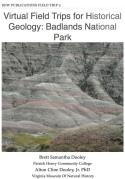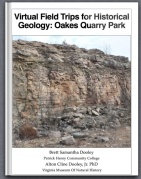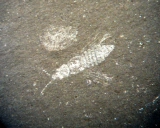I recall a paleontology meeting some years ago where there was an abstract for a poster I had wanted to see; I no longer recall the details, but it was the first report of some type of animal from a particular location. We receive the abstracts well in advance of the meeting, so we can plan which talks and posters we want to see. When the meeting was finally held, I went with some friend to see the poster, only to find a single sheet of paper tacked to the wall where the poster was supposed to be. In essence, it said “Sorry, we misidentified the specimen, it turns out there’s nothing to report here.” I remember we all cringed a bit in sympathy, thinking, “God, I hope that never happens to me! The only thing that would be worse was if it was published!”
Which brings me to Jeffersoniana 24…
I reported this tooth as the first beaked whale found at Carmel Church. I first announced it on this blog with a tentative identification in February 2010. After receiving some feedback (mostly by email), I included the tooth in my presentation at the 3rd SeAVP meeting. Finally, I submitted a manuscript to Jeffersoniana interpreting the tooth as a ziphiid, and after receiving favorable reviews the paper was published online on October 22, 2010. I reported the publication here the same day.
This seemed a pretty solid identification. At least five other marine mammal workers, including several that have published on beaked whales, had seen images of the tooth or the tooth itself, or had reviewed the manuscript. There were several features of this tooth that strongly suggested a beaked whale, and it is pretty similar to some modern beaked whales such as Indopacetus pacificus (below, from Dalebout, 2003):
A few days ago, I received an email from avocational paleontologist Gary Grimsley, who suggested that the Carmel Church tooth looked like a large fish Eocene fish called Brychaetus muelleri, which has been reported from the Nanjemoy Formation. Here are some examples (retrieved from here) of B. muelleri; note in particular the one on the left:
Same size, same shape, same tiny enamel crown…this really looks like the Carmel Church tooth. Moreover, as I’ve mentioned in previous posts, at Carmel Church we get Nanjemoy fossils reworked into the Calvert Formation without any evidence of abrasion, so the fact that the Carmel Church tooth was found in the Calvert in no way precludes this tooth from being Brychaetus. Even though I need to do some more checking, I’m pretty well convinced; the tooth is B. muelleri, and so far no beaked whale has been found at Carmel Church. A better reconstruction for this animal would be its closest living relative, the giant freshwater fish Arapaima gigas from South America:
So, as I say, a paleontologist’s worst nightmare realized. I’m already working on a manuscript about Nanjemoy fossils at Carmel Church being reworked into the Calvert, and I’ll be adding a reinterpretation of this specimen to the paper. Several friends and colleagues have told me over the last few days I shouldn’t feel too bad about it. After all, the paper was peer-reviewed, and I sought out and received a lot of input before publishing. It really does look a lot like a beaked whale tooth. Brychaetus had never been found at Carmel Church before, it’s rare in the Nanjemoy, and only a few images have been published. Nevertheless, it still stings. So, trying to turn lemons into lemonade, what can we learn from my mistake?
First, I want to point out again that this error was caught by an avocational paleontologist. I have always been a proponent of the idea that anyone can make contributions in paleontology, regardless of degrees or titles. “Professionals” (whatever that means) can make mistakes, and anyone can learn geology and anatomy and make observations. I’m grateful to Gary for pointing out my mistake.
Second, among certain groups these days (particularly among the creationist/”intelligent design” crowd) it has become customary to concoct stories of conspiracies in which scientists suppress data that are at odds with some supposed “favored narrative”. It’s hard to express how offensive this is to scientists, since it’s antithetical to the very definition of science. Scientific thought is arguably the most successful method of problem-solving in human history, and the biggest reason is that it constantly seeks to test itself and self-correct. I hope that standing up and saying, “You know that paper I published last year? Yea, that was wrong.” can serve as an example of how science should work.
Finally, I think this is a prime example of the value of blogging and open-access publication. The photos of this tooth are online for anyone to see. Even more importantly, the interpretation was published in Jeffersoniana, which is an open-access pdf journal that anyone can download; that’s how Gary found out about the tooth. Less than a year after the interpretation of this tooth as a beaked whale was published, the error had been found. Jeffersoniana was originally a printed journal, and only about 200 copies of each issue were printed. If this paper had been published that way, how long would it have taken before someone read the paper and made the connection with Brychaetus? Likely decades. Science thrives on communication, and open access online publications accomplish that more effectively than any other means that have been employed to this point.
Thanks again (really!) to Gary, for bringing Brychaetus to my attention.
Reference:














While it may sting a bit on a personal and even a professional level, it strikes this observer that this is less something to be ashamed of and more something to be celebrated. An error was caught, acknowledged, and corrected. The scientific method works. Everybody wins. Hooray for open, accessible scientific dialogue!
Thanks, Ron. That’s what I keep telling myself, intellectually.
You don’t have to worry about misinterpretations. I have found in pliocene sediments a lot of miocene fossils without any reworking (rodent and reptilia teeth) and the first time I was shocked because I didn’t know what was happening because it couldn’t be possible.
But after some talking and showing the fossils to other people you learn that sometimes some weird things happen inside the stratigraphical record. But that’s it, you only have to change the interpretation, and that’s good because you reached your objective.
Fascinating! What a terrifying fish. If it makes you feel any better, I did a similar thing at the Aquatic tetrapods meeting last month – at Point Reyes (in the Purisima Formation), I collected a large tooth that looked to me like a large odobenid premolar, and I initially thought it was from the gigantic Miocene walrus Pontolis magnus – and I had been showing it around as some possible odobenid tooth. It wasn’t fully prepared (I collected it 48 hours before the conference started), and after returning home, I finished preparing it only to find that it had adhering flaky fish-type bone, and then I realized it was one of the upper “tusks” of the saber toothed salmon Oncorhynchus (formerly Smilodonichthys) rastrosus.
Moral of the story is that there are some gigantic, scary bony fish out there in the rock record.
You’re not the first to misidentify a ziphiid. In Gottfried, Bohaska, and Whitmore (1994) “Miocene cetaceans of the Chesapeake Group”, we reported three ziphiid rostra. Years later, a similar specimen, but with tooth sockets, was discovered, and the specimens were interpreted as pathological (Gerholdt and Godfrey 2010, Enigmatic osteology in Miocene odontocete rostra suggests periostitis). We still don’t know what family the rostra represent, but I won’t bet on Ziphiidae.
You may want to read up on Nebraska Man, which turned out to be the Pliocene peccary Prosthennops. As Stephen J. Gould pointed out, when the mistake was realized, it was promptly published, which is how science is different from other fields. If you’re not making mistakes, it means you’re not doing anything.
Butch
As a toxicologist I have had papers which I have been cited ulled. An honsest mistake is a giant step forward because you took time, patience and experience to examine a unusual specimen. Do hope to help you folks out in the fall at Carmel church